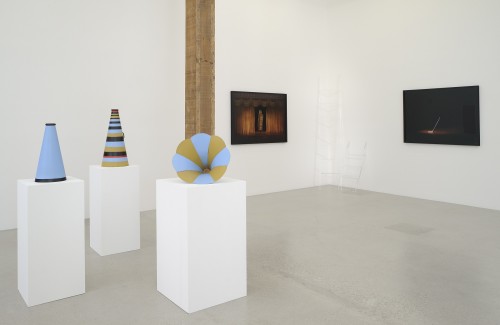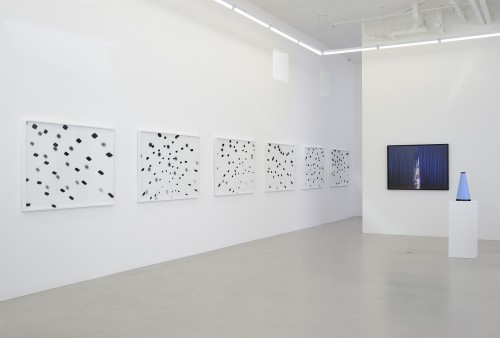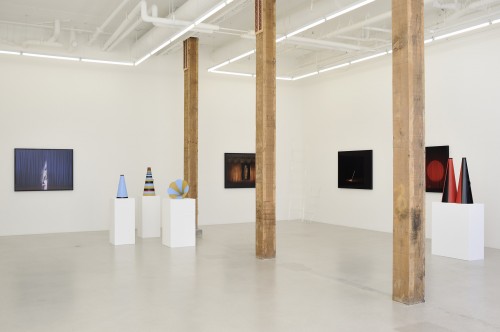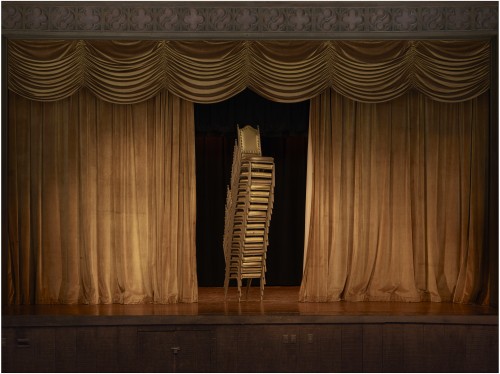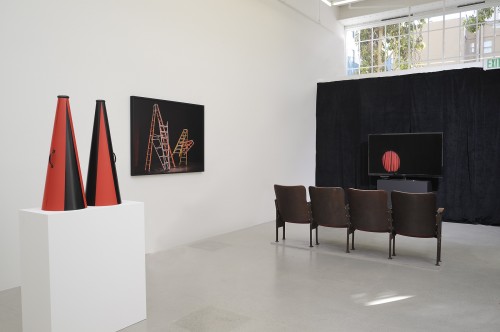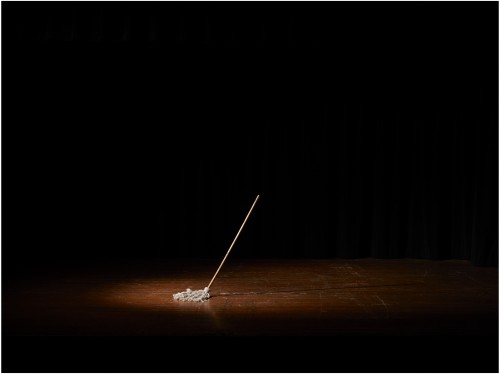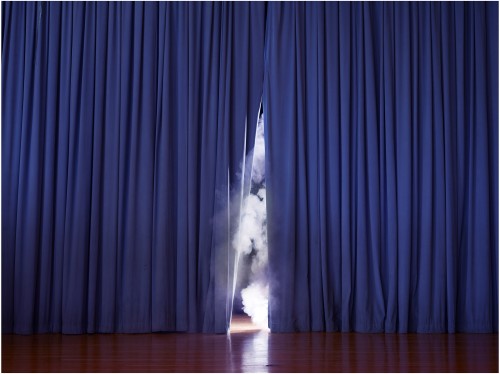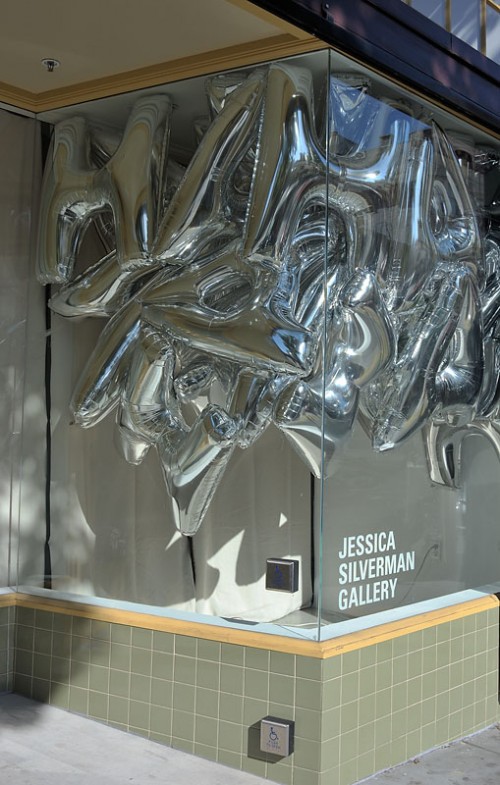“Live From Somewhere” by Tammy Rae Carland
January 24 – March 15, 2014
Jessica Silverman Gallery, San Francisco.
“Live From Somewhere,” a video piece by Tammy Rae Carland for her new show by the same name at Jessica Silverman Gallery is inspired by the opening scene of “Gilda Live” where a spotlight trying to find an absent performer comes to personify the performer’s stage fright. Carland isolates this sight gag and mines the darker side of performance anxiety. In her video, the spotlight nervously paces back and forth across the stage, lowering itself intermittently to rest on the bottom of the curtain, sagging as if tired by its own weight. While a performer can theoretically evade the spotlight, a spotlight can’t escape itself. And while the pressure of the spotlight might be a heavy one, the alternative is the shadowy business of being unknown, invisible – an entertainer’s worst fear.
“Live From Somewhere”, is inspired, in part, by Gilda Radner’s filmed one-woman show “Gilda Live”. The title of the exhibition plays on the name of Radner’s original Broadway show, “Live from New York”. The ambiguity of Carland’s title situates the viewer in her headspace – one of an artist who seems determined to examine the moment she’s in, even if she’s not sure what it means.
After seeing the show, the first thing I did was look up YouTube videos of “Gilda Live”. I realized I had seen Radner’s work so many times when I was younger, on loop on Comedy Central, that I had internalized it and forgotten I had seen most of it at all. How could I have forgotten Roseanne Roseannadanna with her story about chair-farting in Walter Cronkite’s office? The torch of Radner’s genius has been carried on by generations of new comediennes: Tina Fey, Kristen Wiig and notably Molly Shannon whose “Saturday Night Live” character Mary Catherine Gallagher and movie “Superstar” seem directly inspired by many scenes in “Gilda Live” – especially Radner’s “Audition” skit. “Audition” is enacted as a flashback to her ‘first audition,’ which is a parody of the classic “Chorus Line” song and dance routine. As Radner tap dances (buffalo-ball-change) her way across the stage, she is both a parody of the nervous, aspiring actress with amateurish choreography, and a seasoned pro working her ass off to get a laugh. This tension between self-deprecation and bravado is a key element of Radner’s humor.
Carland captures this tenuous position with “Balancing Act,” a photograph of a stage with gold curtains that open on a pillar of stacked chairs. The chairs are stacked high, symbolic of the audience’s expectations; their vulnerability as a structure reflects the precariousness of the relationship between the audience and the performer and the many negotiations that must be made to keep the expectations aloft.
“Live From Somewhere,” a video piece installed with a row of theater seating, is inspired by the opening scene of “Gilda Live” where a spotlight trying to find an absent performer comes to personify the performer’s stage fright. Carland isolates this sight gag and mines the darker side of performance anxiety. In her video, the spotlight nervously paces back and forth across the stage, lowering itself intermittently to rest on the bottom of the curtain, sagging as if tired by its own weight. While a performer can theoretically evade the spotlight, a spotlight can’t escape itself. The pressure of the spotlight might be a heavy one, but the alternative is the shadowy business of being unknown, invisible – an entertainer’s worst fear.
In the photograph “Ghostlight,” a mop is spot lit and propped upright, animated, as the title suggests, by supernatural energies- ghosts of female performers past. The mop was a trademark of another iconic comedian, Carol Burnett. It is a prop from her melancholy “Sign off song” and her cartoon avatar at the end credits of her show. The household tool embodies the mundane realities of housework in contrast to the glamour of the stage or for Carland, the dramatic ups and downs of the artist’s studio.
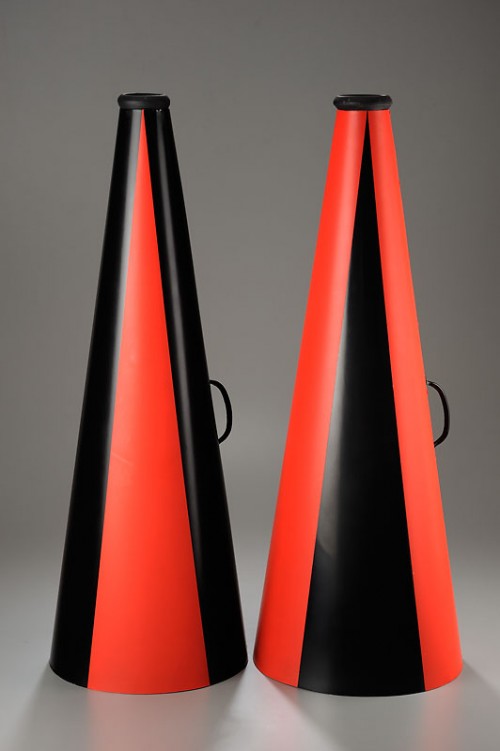
Mime 2
Aluminum, ceramic, paint, cast
2 at 30 x 11 x 11 inches
2013
Courtesy of Jessica Silverman Gallery.
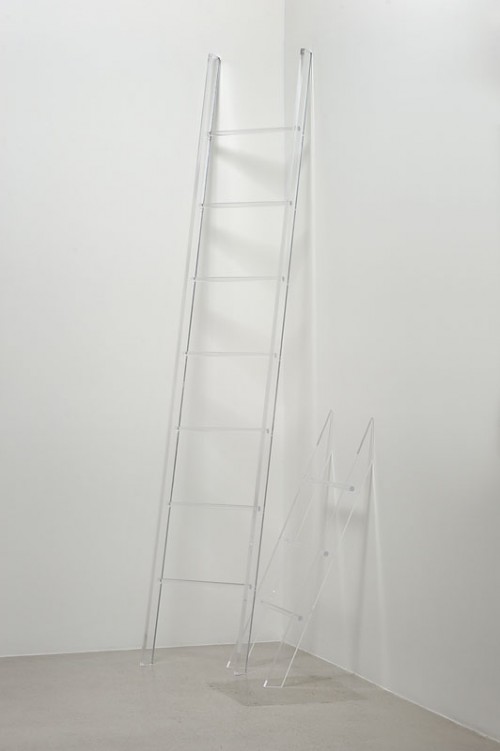
Pratfall Effect 1
Polished acrylic
96 x 17 x 2.5 inches
42 x 17 x 2.5 inches
2013
Courtesy of Jessica Silverman Gallery
Carland’s series of sculptures for the show function as props. The “Mime” pieces, painted megaphones, embody the latent desire to be heard. The ladders, titled “Pratfall Effect” after a term that refers to a performer’s gain or loss in attractiveness after a mistake, are symbols for the fragile ego of performers who are ever at the mercy of their audience.
“Smoke Screen,” presents an image of an empty stage as a back-lit fog creeps out between a small opening in the curtains. The screen of smoke and curtains conceal the machinery that goes into producing the fantasy that the viewer sees. The smoke’s tantalizing plumes suggest the mystery of the anticipated performer, but as there is none it becomes the subject of the photo.
The exhibition statement points to the absence of the performer as a manifestation of performance anxiety, but it also got me thinking about the interchangeability of a performer. By isolating all these theatrical tropes on an empty stage, Carland invites the viewer to identify with them and to think about the way they contribute to the performer’s onstage persona. In pop culture in particular, performers and artists are churned out following prescriptive formulas: boy bands, blonde ingénue, and charismatic male singer. Does it matter who is in the spotlight as long as there is someone there to fit a given role? Once you’ve ‘made it’ the fear of struggling in obscurity forever gives way to the second greatest fear of all creatives: the fear that you are not unique, that you are replaceable.
In the closed off display window of the gallery on the not-yet-gentrified Ellis Street, a dozen or so metallic balloons shaped in the letters H and A are unceremoniously mashed against one another in the cramped space. Their letters spell out a chorus of laughter; the canned ha-ha’s of a laugh track, set aside until they are needed for a punch line. This is one of my favorite pieces in the new show by Tammy Rae Carland at the Jessica Silverman Gallery, “Live From Somewhere”. I asked the gallery what the name of the piece was. They said it was part of the installation of the show and not a piece in itself. I thought that was funny.
“Live From Somewhere” is on view through March 15, 2014.
For more information visit Jessica Silverman Gallery, San Francisco.
